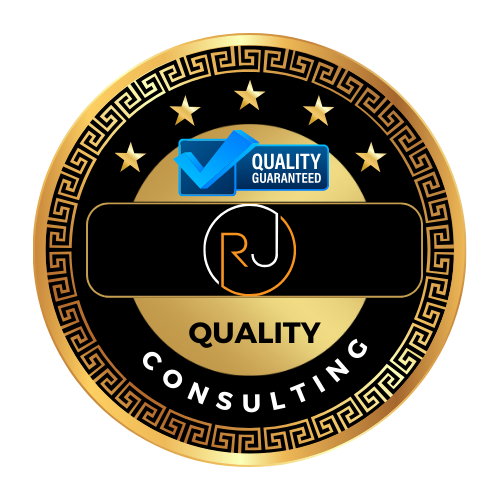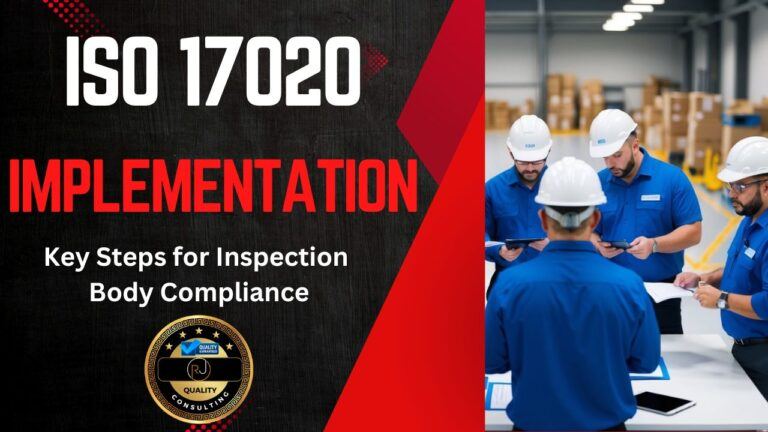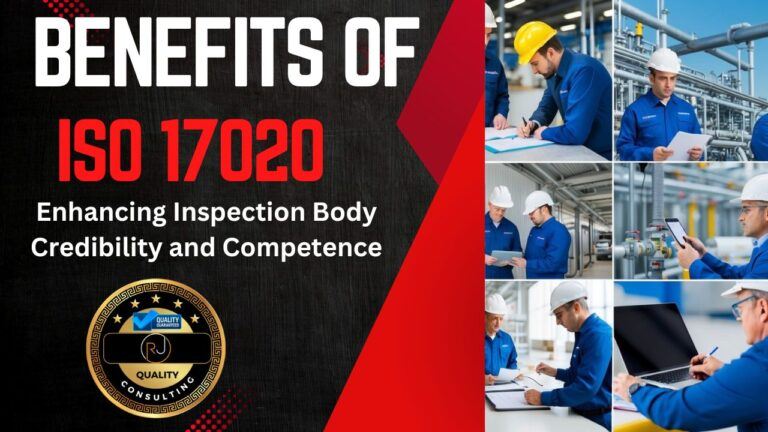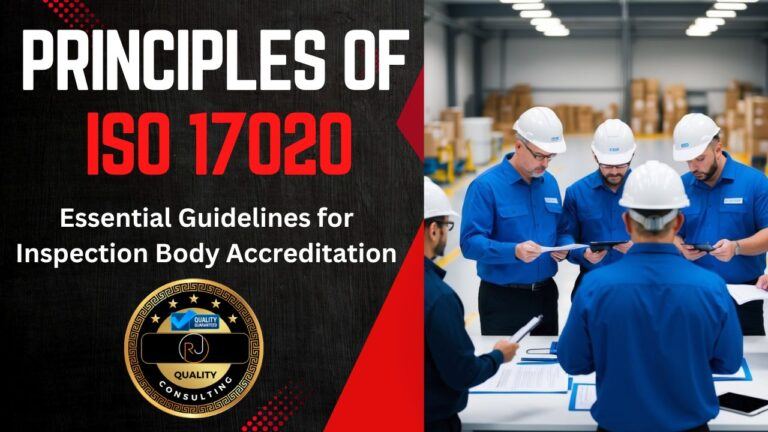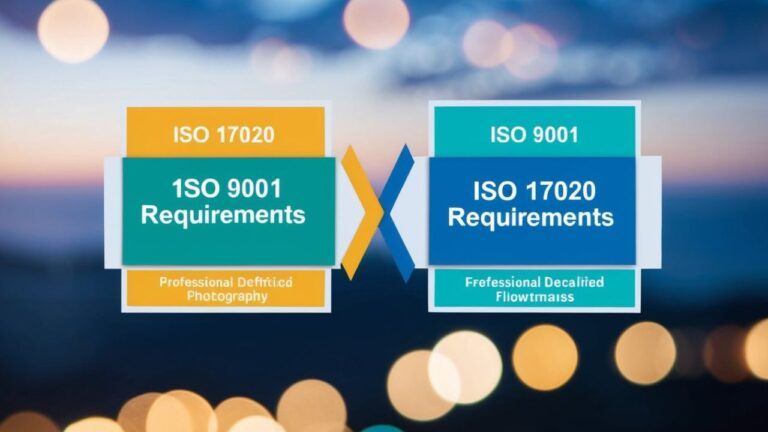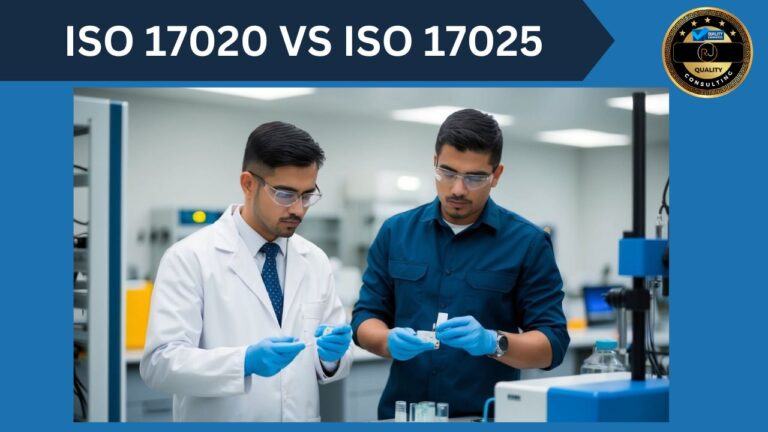Importance of ISO 17020: Ensuring Credibility in Inspection Bodies
ISO 17020 sets the standard for inspection bodies worldwide. It ensures they operate with consistency and quality. Organizations that follow ISO 17020 gain trust from clients and partners. The importance of ISO 17020 cannot be understated for these inspection bodies, for it defines the company’s commitment to quality.

ISO 17020 accreditation proves an inspection body’s competence and reliability. This matters for businesses that need accurate inspections. It helps them make smart choices about products, processes, and services.
Getting ISO 17020 accredited takes work, but it’s worth it. It means better service for customers and a stronger reputation. Plus, it opens doors to new business opportunities.
📘 ISO/IEC 17025 Quality Manual Template
Accelerate your lab’s accreditation process with our comprehensive Quality Manual Template, designed to align with ISO/IEC 17025:2017 standards.
- Fully editable and customizable to fit your laboratory’s needs.
- Includes all necessary procedures, forms, and policies.
- Structured to facilitate easy implementation and compliance.
- Developed by experts with extensive ISO/IEC 17025 experience.
Key Takeaways
- ISO 17020 ensures inspection bodies deliver high-quality, trustworthy results
- Accreditation proves competence and can lead to new business opportunities
- Implementing ISO 17020 improves service quality and builds customer trust
Understanding the Importance of ISO 17020

What is ISO 17020? ISO/IEC 17020 is a crucial standard for inspection bodies. It sets requirements for their competence, impartiality, and consistent operation. The standard applies to various sectors and helps ensure reliable inspection services.
Definition and Scope of ISO/IEC 17020
ISO/IEC 17020 defines criteria for inspection bodies. It covers their management systems, staff qualifications, and inspection processes. The standard aims to make sure inspections are done fairly and consistently.
You’ll find it used in many fields. These include manufacturing, environmental services, and more. ISO/IEC 17020 focuses on key areas:
- Impartiality requirements
- Independence of inspection staff
- Quality control measures
- Reporting procedures
Relevance of ISO/IEC 17020:2012 to Inspection Bodies
The 2012 version of ISO/IEC 17020 is very important for inspection bodies. It helps them prove they can do their job well. This standard makes sure they:
- Have a good management system
- Keep proper records
- Use the right equipment
- Train their staff well
Following ISO/IEC 17020:2012 helps inspection bodies gain trust. Clients know they’ll get reliable results. It also helps bodies improve their work over time.
Types of Inspection Bodies: Type A, B, and C
ISO/IEC 17020 defines three types of inspection bodies:
- Type A: These are the most independent. They don’t design, make, supply, install, buy, own, or maintain the items they inspect.
- Type B: These are part of a larger organization. They inspect items for their parent company’s use.
- Type C: These can inspect items they make or sell. They must have safeguards to ensure fair inspections.
Each type has different rules for independence. Type A bodies have the strictest rules. Type C bodies have more flexibility but must prove they’re still fair.
Key Requirements for Compliance

ISO 17020 sets out specific requirements for inspection bodies to ensure their competence and impartiality. These cover structural, resource, management, and process aspects of inspections.
Structural Requirements for Inspection Bodies
You need to set up your inspection body with clear organizational structures. This means defining roles and responsibilities for all staff. You must have measures in place to ensure impartiality. Your inspection body should be free from undue pressures that could affect its judgment.
Create policies to avoid conflicts of interest. Document how you handle confidential information. Make sure your liability arrangements are adequate for your inspection activities.
Resource Requirements and Personnel Competence
Your staff must have the right skills and knowledge for their jobs. Set up training programs to keep their skills up-to-date. Define the qualifications needed for each role.
Provide proper equipment and facilities for inspections. Maintain and calibrate all equipment regularly. Keep records of maintenance and calibration.
Use qualified subcontractors when needed. Monitor their work to ensure quality.
Management System Requirements
Put a management system in place that fits your inspection body’s size and scope. This system should cover all aspects of your operations.
Create clear policies and objectives for your inspection work. Document all your procedures. Implement a system for controlling documents and records.
Conduct internal audits regularly. Review your management system at least once a year. Take action to fix any issues found.
Process Requirements for Inspection Activities
Define clear methods and procedures for your inspections. Make sure these follow relevant standards and regulations. Create checklists or forms to guide inspectors through each step.
Handle and protect items being inspected properly. Keep detailed records of all inspections. These should include observations, data, and conclusions.
Set up a process for dealing with complaints and appeals. Act quickly to resolve any issues raised by clients.
Issue clear inspection reports or certificates. These should include all required information about the inspection and its results.
The Accreditation Process

Getting ISO 17020 accreditation takes time and effort. You’ll need to prepare your organization, go through audits, and make improvements. The process helps you meet high standards for inspection bodies.
Steps to Achieve ISO 17020 Accreditation
To start, review the ISO 17020 standard and check if you meet the requirements. Next, create a quality manual that outlines your policies and procedures. Train your staff on the new processes.
Apply to an accreditation body. They’ll review your documents and schedule an on-site assessment. During this visit, auditors will:
- Check your facilities
- Watch inspections
- Interview staff
- Review records
After the assessment, you’ll get a report. Fix any issues they found. Once you’ve made all needed changes, you’ll receive your ISO 17020 accreditation.
Internal Audit and Continuous Improvement
Regular internal audits are key to keeping your accreditation. Set up a schedule to check all parts of your system. Look for ways to improve your processes.
During audits:
- Review documents
- Observe inspections
- Talk to staff
- Check equipment
Use audit results to make your system better. Update your procedures if needed. Provide extra training for staff. Keep records of all changes and improvements.
Dealing with Non-Conformities and Corrective Actions
Non-conformities are areas where you don’t meet ISO 17020 requirements. When you find one, take quick action to fix it.
Steps to handle non-conformities:
- Identify the root cause
- Plan how to fix it
- Make the needed changes
- Check if the fix worked
Document all corrective actions. Show what you did and how it solved the problem. This proves you’re committed to meeting ISO 17020 standards.
Maintaining Impartiality and Independence

ISO 17020 stresses the importance of impartiality and independence for inspection bodies. These principles help ensure trustworthy results and maintain credibility. Let’s look at how inspection bodies can uphold these key values.
Mitigating Conflicts of Interest
To stay impartial, you must identify and address potential conflicts of interest. This means setting up clear policies and procedures. You should:
- Separate inspection activities from other business functions
- Rotate inspectors regularly to avoid familiarity with clients
- Train staff on ethics and impartiality
- Have a system to declare and manage conflicts
It’s crucial to keep commercial and financial pressures from swaying your judgment. You might need to turn down work that could compromise your independence.
Ensuring Credibility Through Impartiality
Your reputation depends on fair and unbiased inspections. To boost credibility:
- Document all inspection processes
- Use standardized methods and checklists
- Keep detailed records of inspections
- Have a robust complaint handling system
You should also consider getting accredited by a recognized body. This shows your commitment to quality and impartiality. Regular audits can help you spot and fix any issues with your impartiality measures.
Remember, your clients rely on your independence. By staying impartial, you provide more valuable and trustworthy inspection services.
Benefits of Implementing ISO 17020

ISO 17020 offers inspection bodies many advantages. It boosts credibility, improves operations, and increases global competitiveness. Let’s look at some key benefits.
Enhancing Consistency and Reliability of Inspections
ISO 17020 helps inspection bodies create consistent processes. This leads to more reliable results. The standard sets clear rules for how inspections should be done.
You’ll have better control over your inspection methods. This means fewer mistakes and more accurate findings. Your clients can trust that they’ll get the same high-quality service every time.
The standard also requires regular staff training. This keeps your team’s skills sharp and up-to-date. You’ll be able to handle new challenges and technologies with ease.
Gaining a Competitive Advantage
With ISO 17020 certification, you stand out from other inspection bodies. Many clients prefer to work with certified organizations. This can help you win more contracts and grow your business.
You’ll also improve your internal processes. This can lead to cost savings and better efficiency. You might be able to offer faster turnaround times or more competitive pricing.
The standard encourages continuous improvement. This keeps you ahead of the curve in your industry. You’ll be ready to meet new market demands and client needs.
Fostering International Recognition and Credibility
ISO 17020 is an international standard. This means your certification is recognized worldwide. You can more easily expand into new markets and work with global clients.
The standard proves your commitment to quality and impartiality. This builds trust with your clients and partners. They know you follow strict guidelines for your work.
You’ll also find it easier to work with other certified bodies. This can open up new partnership opportunities. You might be able to offer more services or take on bigger projects.
Quality Management System Integration

ISO 17020 and quality management systems work together to improve inspection processes. Integrating them helps inspection bodies meet high standards and run smoothly.
Alignment with ISO 9001 Requirements
ISO 17020 and ISO 9001 share many common elements. Both focus on customer satisfaction and continuous improvement. You can align your inspection processes with ISO 9001 principles to create a stronger system.
Start by mapping out how ISO 17020 and ISO 9001 overlap. Look for areas like document control, management reviews, and internal audits. These are key parts of both standards.
Next, create processes that meet both sets of requirements. For example, set up a system to track customer feedback and use it to improve your inspection services. This satisfies ISO 9001’s focus on customer needs and ISO 17020’s emphasis on impartiality.
Developing Effective Quality Manuals and Documentation
A good quality manual is crucial for ISO 17020 compliance. It should clearly describe your inspection processes and quality system. Make sure it’s easy to read and follow.
Include sections on:
- Inspection methods and procedures
- Staff qualifications and training
- Equipment maintenance and calibration
- Handling of inspection samples and results
Keep your documentation simple and focused. Use flowcharts or diagrams to explain complex processes. This makes it easier for staff to understand and follow procedures.
Set up a document control system to manage your quality manual and other important records. This helps you keep track of changes and ensures everyone uses the latest versions.
Regular reviews of your quality manual are important. Update it as needed to reflect changes in your processes or new ISO 17020 requirements.
Operational Excellence in Inspection

ISO 17020 promotes high standards for inspection bodies. It focuses on technical skills and proper procedures. This leads to better inspections and more reliable results.
Best Practices in Performing Inspection Activities
To excel in inspections, you need to follow key steps. Start by planning each inspection carefully. Make a checklist of what to look for and bring the right tools.
During the inspection, be thorough and systematic. Take your time to check everything on your list. Don’t rush or skip parts.
Use the latest technology when possible. Digital tools can help you record data faster and more accurately.
Always follow safety rules. Wear proper gear and be aware of your surroundings.
Keep learning and improving your skills. Stay up to date with new inspection methods and rules in your field.
Creating Comprehensive Inspection Reports and Records
Good reports are crucial for inspection excellence. They show what you found and why it matters.
Write your reports clearly and simply. Use plain language that anyone can understand.
Include all important details:
- Date and time of inspection
- Location
- What you inspected
- Your findings
- Any problems you found
- Photos or diagrams if needed
Be honest in your reports. Don’t hide or change any findings.
Store your reports safely. Use a system that makes them easy to find later.
Keep records of all your inspections. This helps track patterns over time and proves your work.
Managing Feedback and Improvements

Feedback and improvements are key to maintaining ISO 17020 compliance. They help inspection bodies stay on top of issues and get better over time.
Handling Complaints and Appeals Effectively
Set up a clear system for handling complaints and appeals. This shows you take feedback seriously. Train your staff on how to deal with these issues properly.
Make it easy for clients to give feedback. Provide forms or online tools they can use. Respond quickly to all complaints and appeals.
Keep good records of each case. Note what happened and how you fixed it. This helps you spot patterns and prevent future problems.
Use complaints as a chance to improve. Look for the root cause of each issue. Then make changes to stop it from happening again.
Measuring Performance and Pursuing Continual Improvement
Track your performance with key metrics. This could include things like:
- Number of inspections done on time
- Client satisfaction scores
- Error rates in reports
Set goals for each metric. Check your progress often. If you’re falling short, make a plan to do better.
Hold regular management reviews. Look at your performance data and feedback. Decide what needs to change.
Encourage staff to suggest improvements. They often see issues first-hand. Give rewards for good ideas that get put into action.
Keep up with new tech and methods in your field. Always look for ways to do inspections better or faster.
Global Trends and Future of ISO 17020

ISO 17020 is changing to meet new global needs. The standard will keep growing in importance for inspection bodies worldwide.
Adapting to Evolving International Standards
You’ll see ISO 17020 update to match other standards. It will likely include more focus on risk management and impartiality. The standard may also add new tech requirements for digital inspections.
ISO 17020 will probably expand its scope. This could cover new industries and inspection types. You can expect clearer guidelines on using AI and machine learning in inspections.
The standard may also put more weight on sustainability. This could mean adding green practices to inspection processes.
Anticipating Changes in Conformity Assessment Practices
You’ll notice a shift towards remote and virtual inspections. ISO 17020 will likely give more guidance on these methods. This could include rules for video inspections and data security.
The standard may focus more on competence verification. This could mean stricter training rules for inspectors. You might see new ways to test and prove inspector skills.
ISO 17020 could also push for more global consistency. This may lead to better recognition of inspections across borders. You’ll likely see more efforts to align ISO 17020 with other conformity assessment standards.
Frequently Asked Questions

ISO 17020 certification brings many benefits to inspection bodies. It helps them improve operations, maintain integrity, and gain credibility. Let’s explore some key questions about this important standard.
What are the core benefits of being ISO 17020 certified?
ISO 17020 certification shows that an inspection body meets high standards. It proves the organization can do reliable inspections. Certified bodies often get more business and respect in their field.
How does ISO 17020 contribute to the improvement of inspection body operations?
ISO 17020 helps inspection bodies work better. It sets rules for how to do inspections and manage the process. This leads to more accurate results and happier clients.
What is the significance of ISO 17020 in maintaining impartiality and confidentiality in inspection activities?
ISO 17020 makes sure inspections are fair and private. It requires bodies to have rules to prevent bias. It also tells them how to keep client information safe.
How does ISO 17020 certification affect the credibility and recognition of an inspection body?
ISO 17020 certification boosts an inspection body’s reputation. It shows clients and partners that the body follows strict rules. This can lead to more trust and business opportunities.
What are the steps involved in achieving ISO 17020 accreditation?
To get ISO 17020 certified, you need to:
- Learn the standard
- Check your current practices
- Make changes to meet the rules
- Write new policies
- Train your staff
- Have an audit
- Fix any issues found
- Get your certificate
Can you outline the financial implications of obtaining ISO 17020 certification for an inspection organization?
Obtaining ISO 17020 certification costs money. You’ll need to pay for:
- Training
- New equipment or software
- Consultants (if you use them)
- The audit itself
- Yearly fees to keep the certification
The exact cost depends on your organization’s size and current practices.
🕒 Book Your Free 45-Minute Consultation
Have questions about ISO/IEC 17025 or ISO 9001 implementation or accreditation? Schedule a free 45-minute consultation with me to discuss your Company or laboratory’s needs and how we can achieve compliance together.
Schedule Your Consultation